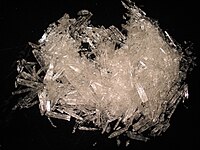
Photo from wikipedia
Abstract In the present study, orientation dependent recrystallization mechanism in pure magnesium is discussed in light of the experimental results. Commercially pure magnesium was subjected to cold rolling of 90%… Click to show full abstract
Abstract In the present study, orientation dependent recrystallization mechanism in pure magnesium is discussed in light of the experimental results. Commercially pure magnesium was subjected to cold rolling of 90% reduction in thickness followed by annealing at 200 °C for different soaking times. Nucleation of no newly oriented grains could be observed during annealing. However, the rate of very low angle grain boundary (VLAGB) movement was found to be the rate controlling step for the formation of recrystallized grains. The formation of sub-grains from the parent grain was observed during annealing of the samples irrespective of the orientation of the grains. However, the rate of sub-grain formation was found to be fastest in the grains of orientations > 40° from the normal direction (ND) of the sample. It was further observed that the growth rate of orientations/grains was decreased with increasing their deviation from ND of the sample. A dominant basal texture was observed in the samples and the maximum weakening of basal texture was observed during 300 s of annealing time.
Journal Title: Materials Characterization
Year Published: 2017
Link to full text (if available)
Share on Social Media: Sign Up to like & get
recommendations!